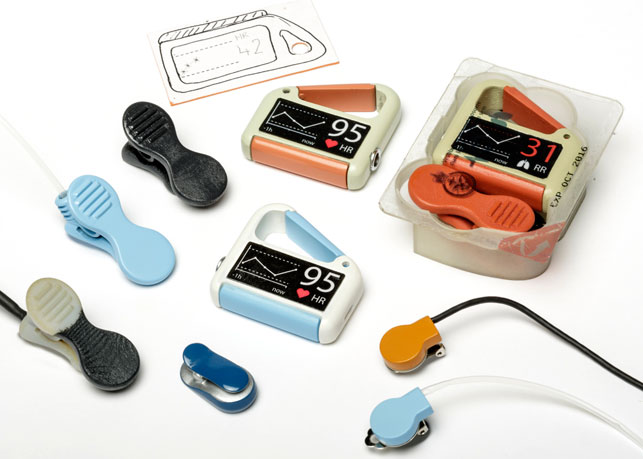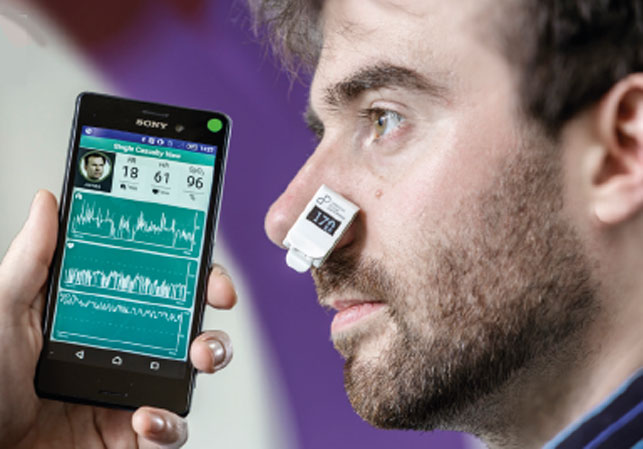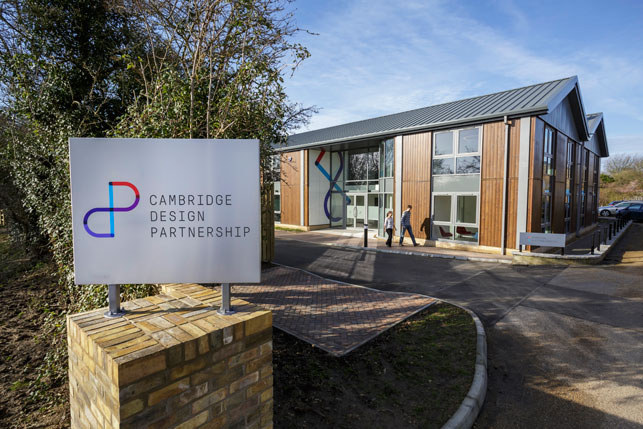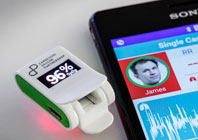Based on the green outskirts of Cambridge, Cambridge Design Partnership (CDP) has recently expanded its footprint to add a large purpose built facility to its converted barn next door.

The First Response Monitor went through many prototype iterations, some as simple as a drawing on a piece of cardboard
With both buildings housing 75 staff – ranging from graphic and user interface designers, to CAD designers and electrical engineers – there’s a lot going on, yet despite that, much of it is hidden from view.
On the ground floor of the new building are custom designed prototyping workshops, including separate rooms for 3D printing, electronics work, and a one-way mirror consumer insight testing space.
The upper floor is formed of separate meeting rooms, connected by an ‘innovation wall’ that transitions through the range of work CDP has produced over the past 20 years. With the majority of CDP’s clients working in either the medical or consumer products, there is a wide array of recognisable products. From a gleaming showroom-ready prototype of an ice cream dispenser, to a cardboard mockup of a popular vacuum cleaner, it makes it easy to get an idea of the scale of the clients that the company works with.

The ‘Innovation Wall’ that displays an array of CDP’s designs
Latest designs
Although most projects remain firmly under the cloak of client confidentiality, the work that CDP is allowed to break cover on is still eye-catching.
The First Response Monitor (FRM) is one of its latest products, and a device demonstrating both the company’s consumer and healthcare design knowledge.
The FRM clips onto a person’s nose, providing at-a-glance displays of both heart and respiratory rates. The data can be collected from multiple monitors and displayed live on a single mobile device.
Initially the design began as part of a brief to create an integrated patient monitor for the Ministry of Defence, which wanted a product that could measure everything you could possibly need to know about a patient: blood pressure, temperature, heart rate, breathing rate, and heart rhythm. Furthermore, it wanted it all in a compact form to give to frontline paramedics for use at point of injury while waiting for medical evacuation.
Having designed a winning concept for the pitch – a slightly cumbersome suitcase-sized unit that ticked all the MOD’s boxes – the team at CDP reverted back to the initial brief to challenge what was being asked.

The FRM connects to the nose, measuring heart and breathing rate
“We came to the conclusion that it was actually the wrong brief,” says project lead Ben Crundwell. “Really what we should be doing was going and talking to frontline medics and getting a better picture of what the scenarios are, what the problems are that they suffer, and try and develop that spec into something that’s a better, more useful device.”
After interviewing a wide selection of experienced field medics at army bases around the UK it created a very detailed picture of what would and wouldn’t work. Either because of weight, size or power method, none of their equipment seemed to work together in a seamless fashion like you’d hope it would, so often much of it got left unused or back at base.
The medics also ranked all the various life signs that they would want to measure, rating them in order from the most important to know when they have 30 minutes to keep someone alive where they’ve fallen.
The front-runners were heart and breathing rate.
The idea CDP reached was to create a device that didn’t attempt to do everything – as the MOD brief stated – but something that would do the most important things best, and so save more lives than an unused, unloved device.
The FRM would just measure the two most vital signs, but from these, identify the patients whose condition – if they focussed their limited resources on for half-an-hour – could possibly be stabilised before a helicopter arrived.
Challenging design
To monitor heart rate the product needed access to the skin, while measuring breathing rate required a sensor somewhere near the mouth or nose. With the initial influences coming from lightweight, inexpensive SPO2 monitors that clip to the finger, the idea was to make the FRM clip to the nose.
The next challenge was how to display the information. Whether by built in screens, or by wirelessly directing it to a phone or tablet. For CDP the best way to find out was to make a number of initial prototypes, the most basic being a piece of cardboard simply with a picture of a dog-tag-style device drawn on it.

Low power Bluetooth transmits the data to a mobile device, where a medic can assess data from a number of devices to make life saving decisions
“We gave that to medics that had been out to Afghanistan and seen it all. In their heads they could imagine the product in the situation and then give us feedback on if it was good or not,” comments Crundwell.
Various different prototypes were storyboarded, moving quickly into 3D design in SolidWorks and on into 3D printed prototypes to create functional prototypes.
This enabled a fast moving process, whittling the idea down to a single sensor clip that can link to a medic’s smartphone via low power Bluetooth, that could be carried by each soldier as part of their on-person med kit.
Once activated, nearby FRM units connect to an app, all the live data appears on a single screen together, helping a medic prioritise the injured at a glance via colour-coding and graphs.
Currently a working prototype in testing, CDP is developing the FRM towards manufacture, yet it has already been the recipient of two Red Dot awards in two wildly different categories – Communications and Life Sciences.
The potential for the product, designed to be small, cheap, light and almost throw-away in its nature, is incredible, with ideas ranging from athlete performance monitoring to prescreening in hospital waiting rooms after a major disaster.
For CDP the development process is ongoing, but it reflects just how tooled-up the company is – to tackle such a project in a relatively short period of time – effectively completing two briefs, while researching, designing, and building a fully working connected device complete with UI.
With more diverse fields merging into traditional product design, and electronics, sensors and UI becoming more commonplace in everyday objects, CDP appears to have readied itself perfectly for the future.

CDP’s purpose built headquarters in Cambridge, UK
cambridge-design.co.uk
Cambridge Design Partnership prepares for the coming challenge
Default






